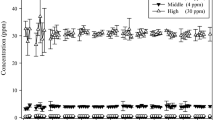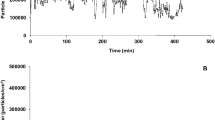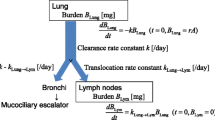Abstract
The uptake and the tissue distribution of ethylmercuric chloride (EMC) by inhalation and oral administration were studied in adult female rats. The pulmonary uptake of EMC linearly increases with the time of exposure and is proportional to the concentration of EMC vapor. With the exception of stomach, intestine, and hair, the tissue distribution of203Hg from pulmonary uptake is quite similar to that from oral administration. The biological halflife of EMC in the organs is longer from pulmonary uptake than from oral administration. Kidney and liver convert EMC to in-organic mercury irrespective of the routes of administration. A small amount of203Hg is found in the fetus, and the fetal liver accumulates more203Hg than the fetal kidney.
Similar content being viewed by others
References
Berglund, F.: Experiments with rats relating to the toxicity of methyl mercury compounds. Nord. Hyg. T.50, 118 (1969).
Berlin, M., and S. Ullberg: Accumulation and retention of mercury in the mouse, III. An autoradiographic comparison of methylmercuric dicyandiamide with inorganic mercury. Arch. Environ. Health6, 610 (1963).
Berlin, M., J. Fazackerly, and G. Nordberg: The uptake of mercury in the brains of mammals exposed to mercury vapor and to mercuric salts. Arch. Environ. Health18, 719 (1969).
Cassano, G. B., P. L. Viola, B. Ghetti, and L. Amaducci: The distribution of inhaled mercury (203Hg) vapors in the brain of rats and mice. J. Neuropath. Exp. Neurol.28, 308 (1969).
Clarkson, T. W., and M. R. Greenwood: Selective determination of inorganic mercury in the presence of organomercurial compounds in biological material. Anal. Biochem.37, 236 (1970).
Gage, J. C.: The distribution and excretion of inhaled mercury vapor. Brit. J. Ind. Med.18, 287 (1961).
Hayes, A. D., and A. Rothstein: The metabolism of inhaled mercury vapor in the rat studied by isotope techniques. J. Pharmacol.138, 1 (1962).
Magos, L.: Mercury-blood interaction and mercury uptake by the brain after vapor exposure. Environ. Res.1, 323 (1967).
Magos, L.: Uptake of mercury by the brain. Brit. J. Ind. Med.25, 315 (1968).
Miller, V. L., G. E. Bearse, Y. Kimura, and E. Csonka: Strain differences in mercury retention by chicks. Proc. Soc. Exptl. Biol. Med.100, 301 (1959).
Miller, V. L., P. A. Klavano, A. C. Jerstad, and E. Csonka: Absorption, distribution, and excretion of ethylmercuric chloride. Toxicol. Appl. Pharmacol.3, 459 (1961).
Miller, V. L., D. V. Larkin, G. E. Bearse, and C. M. Hamilton: The effects of dosage and administration of two mercurials on mercury retention in two strains of chickens. Poultry Sci.46, 142 (1967).
Miller, V. L., and E. Csonka: Mercury retention in two strains of mice. Toxicol. Appl. Pharmacol.13, 207 (1968).
Norseth, T. and T. W. Clarkson: Studies on the biotransformation of203Hg-labeled methyl mercury chloride in rats. Arch. Environ. Health21, 717 (1970).
Ostlund, L.: Studies on the metabolism of methyl mercury and dimethyl mercury in mice. Acta Pharmacol.27, Suppl. 1, 1 (1969).
Swensson, A.: Investigation on the toxicity of some organic mercury compounds which are used as seed disinfections. Acta. Med. Scand.143, 365 (1952).
Swensson, A., and U. Ulfvarson: Distribution and excretion of various mercury compounds after single injections in poultry. Acta Pharmacol.26, 259 (1968).
Suzuki, T., N. Matsumoto, T. Miyama, and H. Katsumma: Placental transfer of mercuric chloride, phenylmercury acetate and methyl mercury acetate in mice. Industr. Health5, 149 (1967).
Takeda, Y., T. Kunugi, O. Hoshino, and T. Ukita: Distribution of inorganic, aryl, and alkyl mercury compounds in rats. Toxicol. Appl. Pharmacol.13, 156 (1968).
Takeda, Y., and T. Ukita: Metabolism of ethylmercuric chloride-203Hg in rats. Toxicol. Appl. Pharmacol.17, 181 (1970).
Trachtenberg, I. M.: The chronic action of mercury on the organisms. Current aspects of the problem of micromercurialism and its prophylaxis. Zoorov'Ja, Kiev1969, 292 pp. (In Russian, German translation.)
Ulfvarson, U.: The effect of the size of the dose on the distribution and excretion of mercury in rats after single intravenous injection of various mercury compounds. Toxicol. Appl. Pharmacol.15, 1 (1969).
Author information
Authors and Affiliations
Additional information
COMMUNICATED BY LOUIS LYKKEN
Technical Paper No. 3496, Oregon Agricultural Experiment Station, Corvallis, Oregon.
Rights and permissions
About this article
Cite this article
Fang, S.C., Fallin, E. Uptake, distribution, and metabolism of inhaled ethylmercuric chloride in the rat. Arch. Environ. Contam. Toxicol. 1, 347–361 (1973). https://doi.org/10.1007/BF01985435
Received:
Accepted:
Issue Date:
DOI: https://doi.org/10.1007/BF01985435




